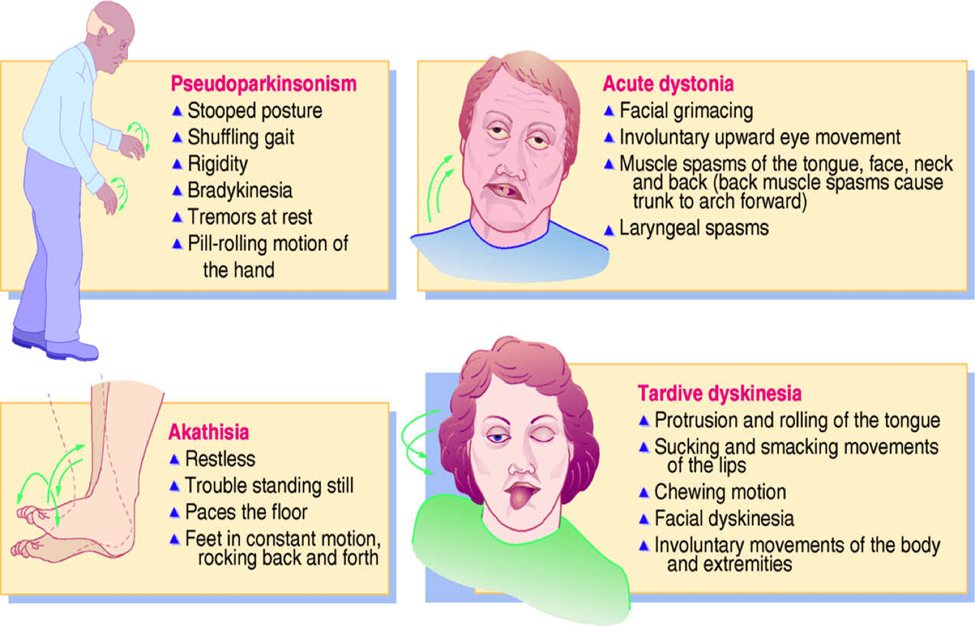A client diagnosed with schizophrenia, who has been taking antipsychotic medication for the last 5 months, presents in an emergency department (ED) with uncontrollable tongue movements, stiff neck, and difficulty swallowing. The nurse would expect the physician to recognize which condition and implement which treatment?
Neuroleptic malignant syndrome, treated by discontinuing antipsychotic medications
Agranulocytosis treated by administration of clozapine (Clozaril)
Tardive dyskinesia treated by discontinuing antipsychotic medication
Headache treated by administration of Hydrochlorothiazide
The Correct Answer is C
A. Neuroleptic malignant syndrome, treated by discontinuing antipsychotic medications: The symptoms described (uncontrollable tongue movements, stiff neck, difficulty swallowing) are more indicative of tardive dyskinesia than neuroleptic malignant syndrome. Neuroleptic malignant syndrome is characterized by hyperthermia, autonomic dysregulation, altered mental status, and generalized muscle rigidity. Treatment involves discontinuing antipsychotic medications and supportive care.
B. Agranulocytosis treated by administration of clozapine (Clozaril): Agranulocytosis is a rare but serious side effect of clozapine, not a treatment for the symptoms described. The symptoms presented are more consistent with tardive dyskinesia.
C. Tardive dyskinesia treated by discontinuing antipsychotic medication: This is the correct answer. Tardive dyskinesia is a movement disorder characterized by involuntary and abnormal movements, including tongue protrusion and facial grimacing. It can result from long-term use of antipsychotic medications, and discontinuing or reducing the dose of the antipsychotic is a primary intervention.
D. Headache treated by administration of Hydrochlorothiazide: Hydrochlorothiazide is a diuretic used to treat conditions like high blood pressure and edema, not headache or the symptoms described, which are more indicative of tardive dyskinesia.

Nursing Test Bank
Naxlex Comprehensive Predictor Exams
Related Questions
Correct Answer is D
Explanation
A. Less-restrictive alternatives have been tried without success: While it is important to explore less-restrictive alternatives before resorting to medication, the immediate concern is the client's safety and the safety of others. If the client's behavior poses a significant risk, prompt intervention may be necessary.
B. The medication will make the work of the staff easier or safer: While staff safety is important, the primary consideration for administering a prn dose of Haloperidol is the clinical need based on the client's behavior and potential danger to themselves, others, or the environment.
C. The client is willing to accept the medication: Client willingness to accept medication is relevant for promoting collaboration in treatment, but the urgency in administering a prn dose is often based on the client's behavior and the level of risk they pose.
D. The client's behavior indicates possible danger to self, others, or the environment: This is the most critical factor in determining the need for a prn dose. If a client's behavior poses a significant risk, such as aggression, violence, or extreme agitation, administering a prn dose of medication may be necessary to ensure safety and prevent harm.
Correct Answer is B
Explanation
A. Allow the client to pace alone until physically tired: While pacing can be a coping mechanism, leaving the client alone may not be the most therapeutic approach. It is important for the nurse to provide support and assess the client's emotional state.
B. Walk with the client at a gradually slower pace: This is the correct answer. Walking with the client at a gradually slower pace allows the nurse to offer support and engage in therapeutic communication. It provides a calming presence and can assist the client in self-regulating their anxiety.
C. Have a staff member escort the client to her room: Escorting the client to her room might be perceived as restrictive or punitive. It is generally more beneficial to engage in supportive interventions and encourage coping strategies.
D. Instruct the client to sit down and stop pacing: Giving direct orders to stop pacing may increase anxiety and may not be an effective approach. It is often better to engage in a supportive manner and explore ways to help the client manage their anxiety.
Whether you are a student looking to ace your exams or a practicing nurse seeking to enhance your expertise , our nursing education contents will empower you with the confidence and competence to make a difference in the lives of patients and become a respected leader in the healthcare field.
Visit Naxlex, invest in your future and unlock endless possibilities with our unparalleled nursing education contents today
Report Wrong Answer on the Current Question
Do you disagree with the answer? If yes, what is your expected answer? Explain.
Kindly be descriptive with the issue you are facing.
